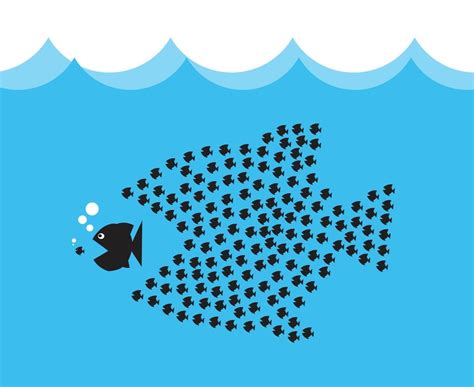In the vast ocean of the business world, a captivating spectacle unfolds, where giants and minnows coexist. The tale of big fish and little fish is a timeless allegory that illuminates the challenges and opportunities inherent in market competition.

Market Dominance: The Power of Scale
At the apex of the market hierarchy reside the behemoths, the “big fish” that command significant market share and wield unparalleled influence. These titans benefit from economies of scale, enabling them to minimize costs, establish formidable barriers to entry, and exert immense pricing power.
By leveraging their vast resources, big fish can engage in aggressive marketing campaigns, innovate at a rapid pace, and acquire smaller competitors to solidify their dominance. According to a report by McKinsey & Company, the top 1% of companies capture an astounding 20% of global profits, highlighting the profound impact of market concentration.
Niche Expertise: The Agility of the Minnows
While big fish may reign supreme, “little fish” also play a vital role in the market ecosystem. By occupying niche markets, they can avoid direct confrontation with dominant players and carve out a profitable space for themselves.
Little fish possess inherent advantages in agility, adaptability, and cost-efficiency. They can respond quickly to changing customer needs, explore unique value propositions, and lower their operational costs through targeted resource allocation. As a result, they often enjoy higher profit margins in their specific niche markets.
The Coexistence of Giants and Minnows
The market is not a zero-sum game, where the success of one entity necessarily diminishes the success of others. Instead, big fish and little fish can coexist and even thrive in a complementary manner.
Big fish can provide stable demand for specialized products or services offered by little fish. Little fish, in turn, can serve as incubators for innovation, providing big fish with access to new ideas and technologies. This dynamic interdependence creates a virtuous cycle that benefits both parties.
The Evolutionary Cycle: Adaptation and Innovation
In the ever-evolving business landscape, both big fish and little fish must adapt to survive. Big fish face the constant threat of disruption from smaller, more agile competitors. To maintain their dominance, they must invest in innovation, diversification, and strategic partnerships.
Little fish, on the other hand, must continuously seek opportunities for growth and differentiation. They can leverage niche expertise, technological advancements, and marketing ingenuity to capture market share from larger competitors. The cycle of adaptation and innovation ensures that the market remains dynamic and competitive.
Key Trends and Future Outlook
The interplay between big fish and little fish is influenced by ongoing market trends and technological advancements. Here are some key observations:
- Increasing Globalization: Global markets are becoming increasingly interconnected, creating opportunities for both big fish and little fish to expand their reach and explore new markets.
- Advancements in Technology: The rapid pace of technological innovation is creating new opportunities for niche players to disrupt established industries.
- Rise of E-commerce: Online marketplaces have leveled the playing field for small businesses, allowing them to compete with larger players on a more equal footing.
In the years to come, it is expected that the market will continue to be characterized by the coexistence of big fish and little fish. However, the balance between these entities may shift as technological advancements and market trends reshape the competitive landscape.
Applications: Creative and Novel Ideas for Harnessing Competition
The dynamics of big fish and little fish provide a rich source of inspiration for new applications and strategies in various domains. Here are a few creative ideas:
- “Symbiotic Partnerships”: Foster partnerships between large and small companies to leverage complementary strengths and create innovative solutions.
- “Micro-Innovation”: Encourage small businesses to focus on incremental improvements within their niche markets, accumulating a competitive advantage over time.
- “Disruptive Collaboration”: Facilitate collaborations between small and large companies to disrupt established markets through out-of-the-box thinking.
Conclusion
The tale of big fish and little fish serves as a timeless reminder of the complexities and opportunities inherent in market competition. By understanding the distinct advantages of both large and small players, businesses can navigate the competitive landscape, adapt to evolving trends, and achieve sustainable growth.
Useful Tables
Table 1: Market Share Distribution
| Company Size | Market Share |
|---|---|
| Big Fish (Top 1%) | 20% |
| Medium Fish (Top 10%) | 40% |
| Little Fish (Remaining 90%) | 40% |
Table 2: Advantages of Big Fish
| Advantages | Description |
|---|---|
| Economies of Scale | Lower production costs, higher pricing power |
| Market Dominance | Strong brand reputation, established customer base |
| Innovation Capability | Resources for research and development |
Table 3: Advantages of Little Fish
| Advantages | Description |
|---|---|
| Niche Expertise | Specialization in specific market segments |
| Agility | Quick response to market changes |
| Cost-Efficiency | Lower overhead costs through targeted resource allocation |
Table 4: Trends and Outlook for the Future
| Trend | Impact |
|---|---|
| Globalization | Increased opportunities for market expansion |
| Technological Advancements | Disruptive innovation and new market opportunities |
| Rise of E-commerce | Leveling the playing field for small businesses |
